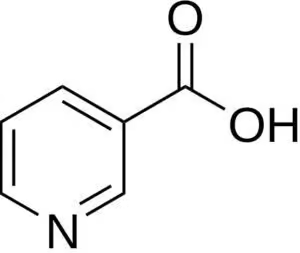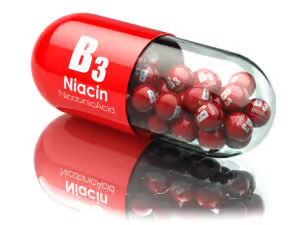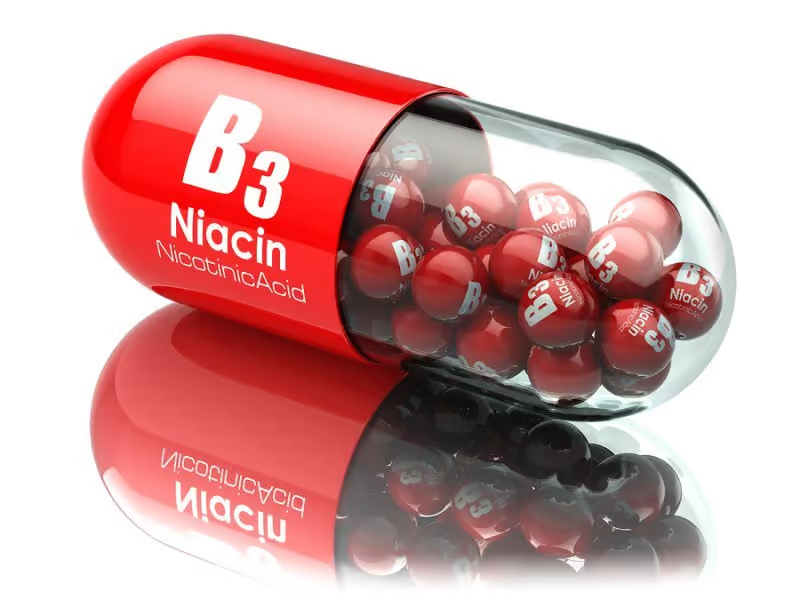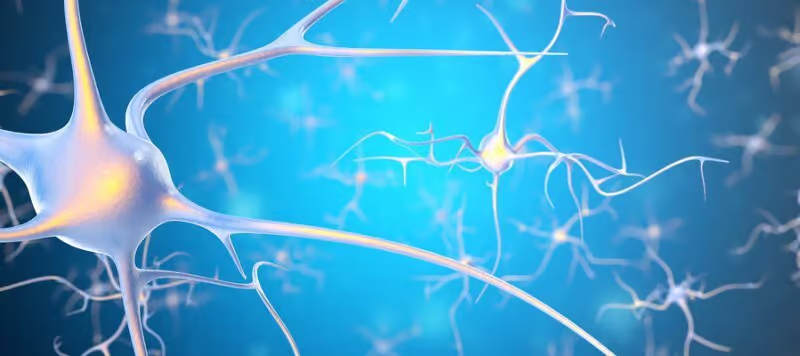Table of Contents
Vitamin B3 (Niacin, nicotinic acid, 3-pyridine-carboxylic acid) is one of eight B-Vitamins. Niacin is a precursor to the coenzymes nicotinamide adenine dinucleotide (NAD), and nicotinamide adenine dinucleotide phosphate (NADP).
NAD is needed to catabolize fats, carbohydrates, proteins and alcohol. And NAD is involved in cell signaling and DNA repair.
NAD also converts to NADH which is the primary carrier of electrons in the transfer of food from your diet into energy. This energy is created as adenosine triphosphate (ATP).
ATP is produced in mitochondria in each of your cells. Not enough NADH leads to ATP depletion, which can eventually lead to cell death.[i]
The Russian-designed nootropic Picamilon is a combination of niacin and GABA. And is used to improve memory, concentration, focus, relieve anxiety and lower blood pressure.
Studies have shown that supplementing with niacin improves cognitive function, enhances cellular energy, boosts cerebral circulation, increases endurance, switches ‘off’ aging genes, and extends life span.
Niacin helps:
- Protect brain cells. Niacin as a precursor to NAD and NADH repairs cell and DNA damage. And stimulates your immune system. Niacin boosts the production of Nitric Oxide (NO) which relaxes blood vessels in your brain increasing cerebral blood flow. And niacin acts as an antioxidant helping to eliminate free radicals that can damage brain cells.[ii]
- Brain energy. As a precursor to NADH, niacin provides electrons for ATP synthesis within our mitochondria for cellular energy. Low levels of niacin result in brain fog, slow mental processing, and cognitive decline.
- Neurotransmitters. Niacin affects cognitive function by stimulating the production of dopamine, norepinephrine and serotonin.[iii] These neurotransmitters are involved in memory, learning, cognition, recall and mood.
Overview
Vitamin B3 (Niacin, nicotinic acid, 3-pyridine-carboxylic acid) is precursor to the coenzymes nicotinamide adenine dinucleotide (NAD), and nicotinamide adenine dinucleotide phosphate (NADP).

Niacin is found in, and critical for the health of every cell in your body. NADH is the reduced form of NAD (Nicotinamide Adenine Dinucleotide), making it the “active” form which can donate electrons.
NADH is the primary carrier of electrons from glucose and lactate for ATP synthesis. ATP is the fuel source produced within mitochondria. The power supply in each of your brain cells. So you need niacin to produce NADH to transfer the energy from the food you eat into a type of energy your body can use.
Niacin naturally occurs in foods like eggs, fish, meat, milk, peanuts, mushrooms, green vegetables, and yeast.
Your body also naturally synthesizes niacin from the amino acid tryptophan you get from food. Amino acid tryptophan synthesis requires Vitamin B6, riboflavin and an enzyme containing iron.
But only about 2% of dietary tryptophan is converted to niacin. Not nearly enough that your body requires which is why supplementation is needed.
Niacin supplementation has been used to treat addiction, ADHD, arthritis, Alzheimer’s Disease, depression, memory loss and schizophrenia. And for detoxing nearly every foreign substance that can find its way into your fat cells.
As a nootropic, niacin helps boost cognition, memory and neuroplasticity.
How does Niacin work in the brain?
Niacin boosts brain health in several ways. But two in particular stand out.
- Niacin increases cellular energy. Niacin is the precursor to NAD. NAD acts as an electron carrier, meaning it can accept and donate electrons to various enzymes involved in energy metabolism.
NAD is transformed into NADH. NADH then donates its electron to the electron transport chain where a number of ATP molecules are formed.
Using niacin as a supplement increases the available NAD molecules that can take part in energy metabolism. And increasing the amount of energy in each cell.[iv]
By providing the means for ATP synthesis, niacin is involved in cognition, focus, concentration, memory, and processing speed. And niacin plays an important role in mediating brain aging and tissue damage. Even decreasing the damage done by strokes.
Researchers at Massachusetts General Hospital in Boston studied the neuroprotective effects of CoQ10 and niacin in mouse models of Parkinson’s Disease (PD). Impaired energy metabolism has been associated with some symptoms of PD.
Researchers administered MPTP which is poison to neurons. It disrupts the energy metabolism of neurons that release dopamine. The affected dopamine cells are also unable to release as much glutamate which results in decreased dopamine in people with PD.
The combination of CoQ10 and niacin protected against both mild and moderate dopamine depletion. The researchers concluded that CoQ10 and niacin improve mitochondrial energy production.[v]
- Niacin increases Brain Derived Neurotrophic Factor (BDNF). BDNF has been termed “Miracle-Gro for the brain”. Higher levels of BDNF have been associated with increased intelligence, mood, productivity and memory.
Researchers at Henry Ford Hospital in Detroit tested the hypothesis that niacin could increase synaptic plasticity and axon growth in stroke patients.
Male Wistar rats were purposely given a stroke and then treated with extended release niacin (Niaspan) for 14 days. Niacin increased synaptic plasticity and axon growth as a result of restored BDNF.[vi]
Another study published in the Journal of Clinical Endocrinology and Metabolism showed that niacin stimulated growth hormone.[vii]
How things go bad
Niacin deficiency is considered rare by government health agencies, particularly in the West. But even mild niacin deficiency can have a negative impact on your health and cognition.
Mild niacin deficiency can be caused by digestive problems that decreases the amount of Vitamin B3 (niacin) or tryptophan that your body absorbs.
If you are gluten intolerant you’re at a higher risk of being niacin deficient. If you have Irritable Bowel Syndrome (IBS) or Crohn’s Disease you have an increased chance of niacin deficiency.
Excessive alcohol consumption, birth control pills, anorexia, and those on a vegan diet can be deficient in niacin.
↓ Energy levels decline
↑ Fatigue increases
↓ Anxiety, hyperactivity, depression, headaches and hallucinations
↓ Metabolism declines
↑ Insomnia increases
↑ Irritability increases
Some experts believe a lack of niacin and other B-Vitamins is at least partially responsible for the large increase in mental health disorders and violent crimes in recent decades.[viii]
All of these niacin deficiency-related changes are contributing factors to the neurodegenerative diseases of aging, age-related cognitive decline, including Alzheimer’s and schizophrenia.
But even if things haven’t degenerated to such a debilitating level, niacin can help.
Niacin Benefits
Research has shown that people with low niacin levels are far more vulnerable to addiction, depression, heart disease, schizophrenia, and other chronic conditions. Low niacin levels can happen at any age. Even at birth.
Niacin can improve cholesterol levels. Supplementing with niacin has been shown to help those who are at increased risk for heart attacks, stroke and other forms of heart disease.
Niacin can help reduce hardening of the arteries (atherosclerosis) and assist in avoiding heart disease. And niacin helps reduce inflammation.
Niacin plays a role in diabetes treatment because it helps balance blood sugar levels.
Niacin helps to reduce skin inflammation, flare ups, irritation, redness and for treating severe cases of acne.
Niacin can help protect against Alzheimer’s and dementia.[ix] Niacin supplementation is also associated with decreased risk for age-related cognitive decline, memory loss, migraines, depression, motion sickness, insomnia and even alcohol dependence.
Niacin is also used for treating and to help prevent schizophrenia.
Studies have shown that when taking niacin ADHD risks are lowered.
Niacin is an effective treatment for erectile dysfunction (ED) because it acts as a vasodilator that helps improve blood flow to the penis.
How does Niacin feel?
Niacin supplementation can help relieve depression and anxiety. Circulation should improve and you’ll feel like you have more energy.
People taking statins to control cholesterol report severe side effects. But when adding niacin to their supplement stack, most experience a reduction in blood pressure. And some have stopped taking statins as a result.
Those dealing with Obsessive Compulsive Disorder (OCD) report combining niacin with St. John’s wort reduced OCD symptoms. And was better than using the SSRI Prozac®, or the benzodiazepine Ativan® (lorazepam).
Taken before bedtime some neurohackers report a reduction in insomnia.
Lower back pain and hip pain may be reduced with niacin supplementation.
Niacin can help reduce severe acne and other skin inflammation problems.
Niacin Clinical Research
Niacin helps Reduce Bad Cholesterol
Therapeutic doses of niacin have been shown to reduce serum cholesterol. Niacin significantly increases HDL-cholesterol (good cholesterol), decreases LPL-cholesterol (bad cholesterol) and triglycerides. Changes in blood lipid profile considered to be protective of your heart.
Low levels of HDL-cholesterol are one of the major risk factors for coronary heart disease. And an increase in HDL levels is associated with a reduction of that risk.
The Coronary Drug Project was conducted between 1966 and 1975 to assess the long-term efficacy and safety of niacin in 8,241 men aged 30 to 64 years old. All men had experienced some type of heart problem.
Compared to placebo, patients who took 3 grams of niacin daily experienced an average 10% reduction in total blood cholesterol, a 26% decrease in triglycerides, a 27% decrease in recurrent heart attacks, and a 26% decrease in stroke.[x]
Niacin for Detox
If you are dealing with chronic health issues, chances are good you could benefit from a detoxification program. Even if you’re feeling perfectly ‘healthy’ you could likely use a good detox.
Simply living in our modern society exposes us to thousands of chemicals that have the potential to get into our bodies from the food we eat, air we breathe, water we drink and things we touch.
One study done in Portland, Oregon investigated the effects of a 7-day detox program on well-being in 25 disease-free, healthy participants. The 7-day detox produced a statistically significant (47%) reduction in the Metabolic Screening Questionnaire scores. And a 23% increase in liver detox capacity.[xi] Even healthy people feel better after detox.
In 1977, L. Ron Hubbard developed his “Sweat Program” to facilitate detox. The program includes niacin, sauna and a supplement regimen to restore critical vitamins and minerals to the newly detoxed body.
This niacin detox program has been used to treat Gulf War Syndrome, the fire fighters and first responders to the 9/11 attacks in New York[xii], and is used by hundreds of naturopaths.
Niacin affects adipocytes which causes an increase in free fatty acid (FFA) release from adipose tissue (body fat). Release of free fatty acids releases fat-stored toxins for excretion from the body.
Niacin also causes prostaglandin D2 release which dilates small blood vessels in the skin. The same reaction responsible for the “niacin flush”. This dilation increases the movement of xenobiotics (foreign chemicals) for excretion through sweating (which is where the sauna comes into the detox program).
Niacin is also a precursor to NADH which regenerates the master antioxidant glutathione. Niacin reduces inflammation by decreasing reactive oxygen species and inflammatory cytokines.
Niacin helps treat Depression
Niacin is especially helpful if you are taking antidepressants. Drugs to treat depression have an anti-inflammatory effect, including inhibition of the rate-limiting enzyme of the kynurenine pathway. This metabolic pathway is involved in the production of NAD and NADH.
The inhibition of this pathway increases serotonin as more tryptophan becomes available for serotonin synthesis. More serotonin helps decrease depression.
But this also leaves less tryptophan available for niacin synthesis. Which causes depression and basically cancels out the benefits of using antidepressants.[xiii]
So if you’re on SSRI’s you may want to add niacin to your stack.
Niacin for the Treatment of Erectile Dysfunction
Dyslipidemia is the name of the condition involving high LDL-cholesterol (bad), high triglycerides (bad), and low HDL-cholesterol (bad). Dyslipidemia is closely related to erectile dysfunction (ED).
Researchers in Hong Kong ran a placebo-controlled trial with 160 male patients with ED and dyslipidemia. Half the men with ED received 1500 mg of niacin, and the other half received a placebo daily for 12 weeks.
The main outcome of the study was a significant improvement in erectile function. And the researchers concluded that “niacin alone can improve erectile function in men suffering from moderate to severe ED”.[xiv]
Niacin Recommended Dosage
Niacin is naturally produced in your body from tryptophan. And you get niacin from eating certain foods including beef, chicken, tuna, sunflower seeds, salmon, green peas, turkey, and mushrooms. So niacin is considered non-toxic and safe.
Note that higher doses of niacin are usually divided into evenly split doses 2 – 4 times per day. So 1 gram of niacin daily would be 500 mg twice per day.
- Prevention of heart disease: niacin 4 grams per day
- Lowering bad cholesterol and boosting good cholesterol: niacin 4 grams per day
- To slow the progression of newly diagnosed type 1 diabetes: Niacinamide 25 mg/kg of body weight daily
- Preventing or treating Vitamin B3 (niacin) deficiency: 50 – 100 mg per day
- To treat pellagra (severe niacin deficiency): 300 – 500 mg daily
- For treating osteoarthritis: Niacinamide 3 grams per day
- For reduced risk of cataracts: 44 mg of niacin per day
- Preventing Alzheimer’s Disease: 100 mg per day. Note that there is no reliable evidence that niacin can prevent Alzheimer’s although there is plenty of evidence that Alzheimer’s patients consistently show low niacin levels.
- Treating erectile dysfunction (ED): 500 mg 3-times per day
- Treating schizophrenia: 3 grams of niacin and 3 grams of ascorbic acid (Vitamin C) daily[xv]
Niacin Side Effects
Standard niacin (nicotinic acid) is naturally produced in your body. And considered non-toxic.
Niacin can cause low blood pressure so if you are on blood pressure drugs be cautious about supplementing with niacin.
Niacin may decrease the effectiveness of diabetes medication because long-term use of niacin can increase blood sugar. So you may need to increase your diabetes meds.
Statins are notorious for causing muscle wasting. And when combined with niacin it may increase this muscle wasting problem. You may want to cut back on your statins as you increase your niacin dose. Many stop taking statins altogether when using niacin.
Niacin (nicotinic acid) and sustained-release niacin causes “flushing” in many people. Here I address how to reduce or eliminate the side effect of niacin flushing.
Preventing Niacin Flushing
Regular immediate-release niacin (nicotinic acid) causes “flushing” in many people. And they avoid supplementing with niacin as a result.
Standard niacin flushing results from activation of the niacin receptor G protein-coupled receptor 109A (GPR109A) in skin Langerhans cells. This leads to the production of prostaglandins, including prostaglandin D2 (PGD2) and prostaglandin E2 (PGE2), which act on receptors in the capillaries (small blood vessels in your skin).[xvi]
This flushing sensation comes from blood vessel dilation and manifests itself as redness, warmth of the skin and tingling or itching. It happens rapidly and lasts for about 1 hour.
This flushing sensation is NOT an allergic reaction. And only feels uncomfortable. Here are some strategies to avoid niacin flushing.
First, “slow-release” niacin may prevent flushing. But is NOT the answer because it will not provide the LDL-cholesterol (bad) lowering benefits. And can be toxic to your liver when used long-term.[xvii]
Inositol hexanicotinate is commonly referred to as no-flush niacin or flush-free niacin and is preferred by many neurohackers.
Even though I’ve seen a couple of clinical studies claiming this version of niacin has no effect on lipid profiles when it comes to cholesterol[xviii], user reviews consistently report the opposite.
They do not experience flushing with Inositol hexanicotinate even at high doses, and their cholesterol and triglyceride levels all benefited and came within a healthy range.
A newer version of “extended-release” niacin called Niaspan® does not produce the flushing effect. And has been shown to have the same effects on good cholesterol and triglycerides as instant-release niacin.[xix] Niaspan® is prescription-only and is now available as a prescription generic at lower cost.
One effective way to reduce flushing with instant-release niacin and extended-release niacin is to take a 325 mg aspirin tablet 30 minutes prior to taking your niacin.[xx]
You can also try splitting your dose of niacin into smaller doses taken throughout the day. Flushing will be reduced if not completely eliminated. And long-term niacin users note that flushing goes away after about a week of long-term niacin use.
Type of Niacin to Buy
Vitamin B3 (Niacin) is not stored in your body and must be ingested daily from food or as a supplement. Niacin as a supplement comes in several forms:
- Niacin (nicotinic acid, (pyridine-3-carboxylic acid) or ‘free-form’ nicotinic acid even at large doses of 3 or 4 grams are nearly completely absorbed by adults. This version causes ‘flushing’ above 50 mg which can be avoided. Refer to the “Side Effects” section of this article on niacin. Doses above 1500 mg per day can be toxic to your liver.
- Niacinamide (nicotinic acid amide) has a similar profile to that of free-form niacin. But unlike free form niacin does not produce a flushing effect. Doses above 3 grams per day can be toxic to your liver.
- Slow-release niacin is nicotinic acid using an ion exchange or wax matrix developed to slowly release niacin to avoid the flushing effect. Liver toxicity has been shown in doses above 500 mg of extended-release niacin.
- Inositol hexanicotinate (IH) is an “extended-release niacin” sold as “Flush Free Niacin” and has 6 molecules of niacin covalently bonded to one molecule of inositol. The IH version of niacin does not produce a flushing effect. Studies show that an average of 70% of the dose you take gets absorbed by your body.
Studies show that the benefits to lowering bad cholesterol with the IH form of niacin are not nearly as effective as free-from niacin.[xxi] But user reviews are the opposite of these clinical findings. No toxicity is associated with high doses of IH.
Slo-Niacin®, is sold over the counter. Niaspan® is an extended-release niacin formula sold as a prescription drug.
Note: Both slow-release niacin and extended-release niacin (inositol hexanicotinate) are marketed and labeled as “Flush-Free Niacin”. But they are not the same and you should avoid slow-release niacin.
Slow-release niacin causes liver toxicity at relatively low doses and does not provide the lipid balancing effects like free-form niacin and extended-release niacin.
Most multivitamins also include some form of Vitamin B3 (niacin) in their formula. But many of these multis don’t contain enough for optimum health. And many have an inferior isolated or synthetic version of the nutrient.
The Performance Lab® NutriGenesis Multi offers a nature-identical form of Vitamin B3 (niacin) and is now my favorite daily multivitamin/mineral supplement.
I prefer the Performance Lab® multi because it’s more potent, it’s biologically active and I’ve found to be a far more effective multi compared to every other multivitamin supplement I’ve ever used.
Performance Lab® uses their own patented NutriGenesis® vitamins and minerals which are grown on probiotic, plant and yeast cultures in a state-of-the-art lab.
Nootropics Expert Recommendation
Vitamin B3 (Niacin) 500 mg twice per day
 I recommend using “extended-release” Niacin (Inositol hexanicotinate) as a nootropic supplement.
I recommend using “extended-release” Niacin (Inositol hexanicotinate) as a nootropic supplement.
Your body does make some Niacin on its own. And you can get it by eating meat, poultry and fish. But studies have shown we don’t get an adequate supply of Niacin from food sources.
Niacin is particularly helpful for vegetarians because very little Niacin is available from vegetables.
Niacin is especially helpful for those suffering Chronic Fatigue Syndrome and ADHD.
I suggest starting with a dose of 500 mg daily. And Niacin is a great compliment to a stack including any nootropic. Do your best to use either free-form niacin if you can tolerate the flush. Or even better, use an extended-release version of niacin that has no flush and no associated toxicity.
You need to provide your brain with the nutrients including niacin needed to create ATP within brain cell mitochondria. Or neurons start to break down from the inside. Signs that you’re lacking adequate Niacin is brain fog, slow thinking, fatigue and low endurance.
Some clinics in the USA and other countries are using Niacin therapy as a treatment for addiction, anxiety, depression, chronic stress and even schizophrenia.
I recommend starting with a low dose of Niacin until you build a tolerance to avoid the niacin “flush”. Increase your dose every few days until you get to the dose you find gives you the most cognitive benefit.
At the very minimum every neurohacker should be using a multivitamin every day that includes Vitamin B3 (niacin). The best multi I’ve found and use every day is the Performance Lab® NutriGenesis Multi for men or women.









Join The Discussion - 231 comments
Raquel
May 28, 2022
Hi David, Niacin and Nicotinamide increased plasma Homocysteine which increases the
risk factor for the development of vascular disease.
Do you think it is safe to supplement with Niacin knowing the risks it has for vascular disease?
Here is the link to the studies:
https://www.nature.com/articles/s41598-019-46120-z
https://pubmed.ncbi.nlm.nih.gov/27567458/
– And my last question is, how many mg of Cordyceps do you consume daily?
David Tomen
May 30, 2022
Raquel, neither of those studies show supplementing with plain old niacin causes problems with homocysteine. What does cause problems with homocysteine is an imbalance of Vitamins B6k B9 and B12. Niacin supplementation does not cause heart disease.
And there is no long-term recommended dosage for Cordyceps. You can use up to 4 grams per day for at least 13 weeks. Beyond that is unknown because not one has studied it. https://nootropicsexpert.com/the-nootropic-benefits-of-medicinal-mushrooms/
Tatiana
May 10, 2022
Hi, I bought a bottle of Niacin (as Niacinamide) 500 mg, of the Brand
Nature´s Way. I would like to know if it is good brand and it this form of Niacin can help me with depression, anxiety and fatigue. I also would like to know if intravenous Nad could be more effective (I found a web that do this kind of treatment). I am desperate. Thank you.
David Tomen
May 11, 2022
Tatiana, niacinamide is very similar to regular niacin but does not produce the flushing effect that many cannot tolerate.
It may help with depression if the depression is caused by problems with serotonin. Because tryptophan which is a precursor to serotonin is also used to produce niacin.
If you are low in niacin the tryptophan in your system will be used to produce niacin instead of serotonin. So, when you supplement with niacin or niacinamide that existing tryptophan in your system is not needed to to produce niacin and can make serotonin instead.
IV NAD can be effective in some cases. It will act quicker but is an expensive way to increase niacin in your body because you would need to do it every day. Supplementing with niacinamide is much more affordable.
John
April 10, 2022
Learn to love the flush!
J
February 22, 2022
* Does longterm high-dose Niacin supplementation cause neurotransmitters to become “sensitized” (towards tolerance/dependence?) Like meds, where you must keep increasing to get benefits?
I have chronic Depression, Fatigue, brain fog (barely helped with low-dose Effexor & Ritalin). The intolerable “drained” fatigue crash happens 1pm-5pm no matter what I eat, amount of sleep, amount of exercise…
I’ve started 2 grams Niacin per day (NOW Foods caps). I love the intense flush feeling, it’s like a brain massage (although I don’t flush when I take with food).. Will splitting my dose after each meal give best coverage throughout day?
So far, I like the natural effect, although short lived (Often when it wears off I’m too relaxed/sleepy)….
I’m desperate to find something that helps my fatigue, motivation and cognition…Also, a bit worried of longterm effects of 2-3 grams daily (insulin problems, liver toxicity, ulcers, UTIs/burning)
David Tomen
February 22, 2022
Scroll up a little and read the section called “Type of Niacin to Buy” and then a little further up to the Side Effects section.
Excess niacin is toxic to your liver. Including regular, plain old niacin above 1,500 mg per day.
Sandra
January 31, 2022
Hi David! For me NADH is too expensive. I suplement with only 17mg of Niacin (which is part of my B complex), is it not enough? Should I invest in some niacin powder and use for ex. 100-200mg per dose? Thanks!
David Tomen
February 1, 2022
Sandra, you likely do not “need” NADH because niacin is a precursor to the various forms of niacin.
But it depends on what you are trying to treat if anything. A good dose of regular niacin is 100 mg per day. Split into two doses if you cannot handle the flush.
Or change your B-Complex to a bioactive one that contains therapeutic amounts of each B-Vitamin. This is the one I use and recommend: https://amzn.to/3LcIpkm
Danny O
January 29, 2022
Hello David,
I’ve been seeing a lot of buzz about Nicotinomide Riboside, which is apparently a superior form that has proven anti-aging, brain health and other benefits related to raising NAD+ levels. What are your thoughts on this particular form?
David Tomen
January 31, 2022
Danny, that is a loaded question. Very recent research argues that NMN is the best way to increase NAD+ as well (https://www.ncbi.nlm.nih.gov/labs/pmc/articles/PMC7238909/). So, either NR or NMN.
Aleksander
November 14, 2021
Hello David!
Would you recommend Niacin as a replacement for NADH. From my B-complex I only get 17mg. What dosage would be better to increase NADH the same way as suplementing NADH directly. Niacin is much cheaper also. Or maybe picamilon could also be an option?
Thank you for everything!
David Tomen
November 18, 2021
Aleksander, any amount of niacin will eventually produce NADH. But NADH declines with age. So if you are older you may want to consider using NADH as a supplement. Otherwise you should be fine with just using niacin. But I would not count on Picamilon as a primary source of niacin because it is bonded to GABA to allow GABA to more easily cross the blood-brain barrier.
Debra Walton
November 8, 2021
Greetings. thank you so much for this information!!!! One question: for the nootropic stack with psilicyban, niacin, and lion’s mane, is the flush necessary for the stack to work or does extended release work just as well?
thank-you
David Tomen
November 8, 2021
Debra, the flush effect of Niacin is not necessary to experience its benefits.
In fact, if you want to use a high dose of niacin your best option is Inositol hexanicotinate (IH) which is an “extended-release niacin” sold as “Flush Free Niacin” and has 6 molecules of niacin covalently bonded to one molecule of inositol. The IH version of niacin does not produce a flushing effect. Studies show that an average of 70% of the dose you take gets absorbed by your body.
Debra Walton
November 9, 2021
thank you so much this is enormously helpful
Hank
January 19, 2022
That’s called the Stamets stack, and Paul Stamets actually recommended using the flushing form of niacin. His thought, although he admits it’s only an educated guess, is the flush of the niacin would increase circulation of the lions mane and psyillsiben to the extremities. His first podcast with Joe Rogan explains this. You could probably find the clip on YouTube, unless Rogan took it down.